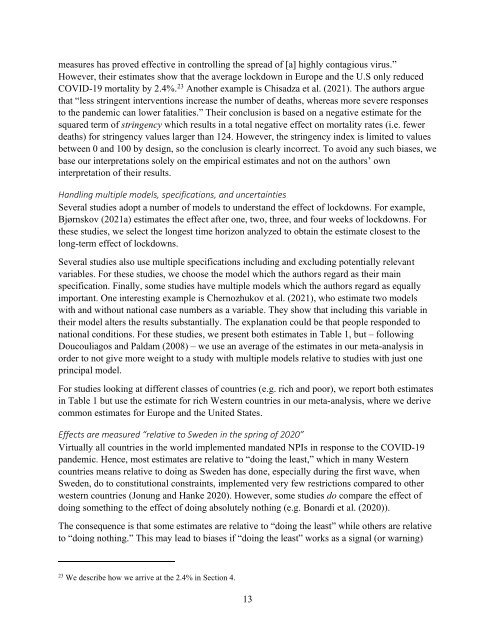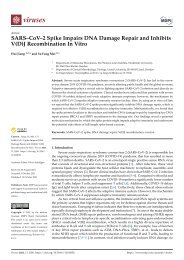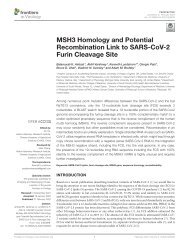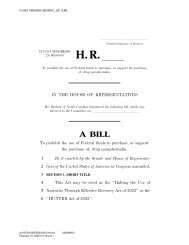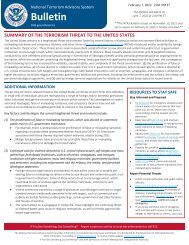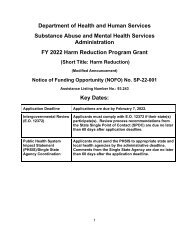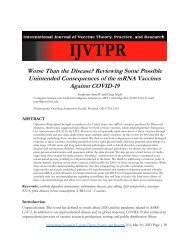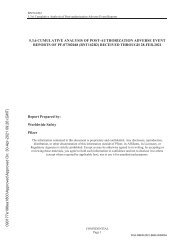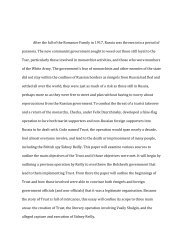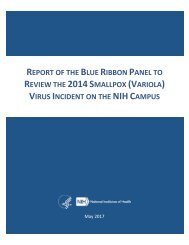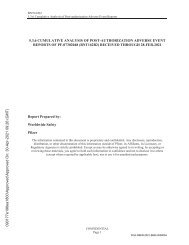A Literature Review and Meta Analysis of the Effects of Lockdowns on COVID 19 Mortality
You also want an ePaper? Increase the reach of your titles
YUMPU automatically turns print PDFs into web optimized ePapers that Google loves.
measures has proved effective in c<strong>on</strong>trolling <str<strong>on</strong>g>the</str<strong>on</strong>g> spread <str<strong>on</strong>g>of</str<strong>on</strong>g> [a] highly c<strong>on</strong>tagious virus.”<br />
However, <str<strong>on</strong>g>the</str<strong>on</strong>g>ir estimates show that <str<strong>on</strong>g>the</str<strong>on</strong>g> average lockdown in Europe <str<strong>on</strong>g>and</str<strong>on</strong>g> <str<strong>on</strong>g>the</str<strong>on</strong>g> U.S <strong>on</strong>ly reduced<br />
<strong>COVID</strong>-<strong>19</strong> mortality by 2.4%. 23 Ano<str<strong>on</strong>g>the</str<strong>on</strong>g>r example is Chisadza et al. (2021). The authors argue<br />
that “less stringent interventi<strong>on</strong>s increase <str<strong>on</strong>g>the</str<strong>on</strong>g> number <str<strong>on</strong>g>of</str<strong>on</strong>g> deaths, whereas more severe resp<strong>on</strong>ses<br />
to <str<strong>on</strong>g>the</str<strong>on</strong>g> p<str<strong>on</strong>g>and</str<strong>on</strong>g>emic can lower fatalities.” Their c<strong>on</strong>clusi<strong>on</strong> is based <strong>on</strong> a negative estimate for <str<strong>on</strong>g>the</str<strong>on</strong>g><br />
squared term <str<strong>on</strong>g>of</str<strong>on</strong>g> stringency which results in a total negative effect <strong>on</strong> mortality rates (i.e. fewer<br />
deaths) for stringency values larger than 124. However, <str<strong>on</strong>g>the</str<strong>on</strong>g> stringency index is limited to values<br />
between 0 <str<strong>on</strong>g>and</str<strong>on</strong>g> 100 by design, so <str<strong>on</strong>g>the</str<strong>on</strong>g> c<strong>on</strong>clusi<strong>on</strong> is clearly incorrect. To avoid any such biases, we<br />
base our interpretati<strong>on</strong>s solely <strong>on</strong> <str<strong>on</strong>g>the</str<strong>on</strong>g> empirical estimates <str<strong>on</strong>g>and</str<strong>on</strong>g> not <strong>on</strong> <str<strong>on</strong>g>the</str<strong>on</strong>g> authors’ own<br />
interpretati<strong>on</strong> <str<strong>on</strong>g>of</str<strong>on</strong>g> <str<strong>on</strong>g>the</str<strong>on</strong>g>ir results.<br />
H<str<strong>on</strong>g>and</str<strong>on</strong>g>ling multiple models, specificati<strong>on</strong>s, <str<strong>on</strong>g>and</str<strong>on</strong>g> uncertainties<br />
Several studies adopt a number <str<strong>on</strong>g>of</str<strong>on</strong>g> models to underst<str<strong>on</strong>g>and</str<strong>on</strong>g> <str<strong>on</strong>g>the</str<strong>on</strong>g> effect <str<strong>on</strong>g>of</str<strong>on</strong>g> lockdowns. For example,<br />
Bjørnskov (2021a) estimates <str<strong>on</strong>g>the</str<strong>on</strong>g> effect after <strong>on</strong>e, two, three, <str<strong>on</strong>g>and</str<strong>on</strong>g> four weeks <str<strong>on</strong>g>of</str<strong>on</strong>g> lockdowns. For<br />
<str<strong>on</strong>g>the</str<strong>on</strong>g>se studies, we select <str<strong>on</strong>g>the</str<strong>on</strong>g> l<strong>on</strong>gest time horiz<strong>on</strong> analyzed to obtain <str<strong>on</strong>g>the</str<strong>on</strong>g> estimate closest to <str<strong>on</strong>g>the</str<strong>on</strong>g><br />
l<strong>on</strong>g-term effect <str<strong>on</strong>g>of</str<strong>on</strong>g> lockdowns.<br />
Several studies also use multiple specificati<strong>on</strong>s including <str<strong>on</strong>g>and</str<strong>on</strong>g> excluding potentially relevant<br />
variables. For <str<strong>on</strong>g>the</str<strong>on</strong>g>se studies, we choose <str<strong>on</strong>g>the</str<strong>on</strong>g> model which <str<strong>on</strong>g>the</str<strong>on</strong>g> authors regard as <str<strong>on</strong>g>the</str<strong>on</strong>g>ir main<br />
specificati<strong>on</strong>. Finally, some studies have multiple models which <str<strong>on</strong>g>the</str<strong>on</strong>g> authors regard as equally<br />
important. One interesting example is Chernozhukov et al. (2021), who estimate two models<br />
with <str<strong>on</strong>g>and</str<strong>on</strong>g> without nati<strong>on</strong>al case numbers as a variable. They show that including this variable in<br />
<str<strong>on</strong>g>the</str<strong>on</strong>g>ir model alters <str<strong>on</strong>g>the</str<strong>on</strong>g> results substantially. The explanati<strong>on</strong> could be that people resp<strong>on</strong>ded to<br />
nati<strong>on</strong>al c<strong>on</strong>diti<strong>on</strong>s. For <str<strong>on</strong>g>the</str<strong>on</strong>g>se studies, we present both estimates in Table 1, but – following<br />
Doucouliagos <str<strong>on</strong>g>and</str<strong>on</strong>g> Paldam (2008) – we use an average <str<strong>on</strong>g>of</str<strong>on</strong>g> <str<strong>on</strong>g>the</str<strong>on</strong>g> estimates in our meta-analysis in<br />
order to not give more weight to a study with multiple models relative to studies with just <strong>on</strong>e<br />
principal model.<br />
For studies looking at different classes <str<strong>on</strong>g>of</str<strong>on</strong>g> countries (e.g. rich <str<strong>on</strong>g>and</str<strong>on</strong>g> poor), we report both estimates<br />
in Table 1 but use <str<strong>on</strong>g>the</str<strong>on</strong>g> estimate for rich Western countries in our meta-analysis, where we derive<br />
comm<strong>on</strong> estimates for Europe <str<strong>on</strong>g>and</str<strong>on</strong>g> <str<strong>on</strong>g>the</str<strong>on</strong>g> United States.<br />
<str<strong>on</strong>g>Effects</str<strong>on</strong>g> are measured “relative to Sweden in <str<strong>on</strong>g>the</str<strong>on</strong>g> spring <str<strong>on</strong>g>of</str<strong>on</strong>g> 2020”<br />
Virtually all countries in <str<strong>on</strong>g>the</str<strong>on</strong>g> world implemented m<str<strong>on</strong>g>and</str<strong>on</strong>g>ated NPIs in resp<strong>on</strong>se to <str<strong>on</strong>g>the</str<strong>on</strong>g> <strong>COVID</strong>-<strong>19</strong><br />
p<str<strong>on</strong>g>and</str<strong>on</strong>g>emic. Hence, most estimates are relative to “doing <str<strong>on</strong>g>the</str<strong>on</strong>g> least,” which in many Western<br />
countries means relative to doing as Sweden has d<strong>on</strong>e, especially during <str<strong>on</strong>g>the</str<strong>on</strong>g> first wave, when<br />
Sweden, do to c<strong>on</strong>stituti<strong>on</strong>al c<strong>on</strong>straints, implemented very few restricti<strong>on</strong>s compared to o<str<strong>on</strong>g>the</str<strong>on</strong>g>r<br />
western countries (J<strong>on</strong>ung <str<strong>on</strong>g>and</str<strong>on</strong>g> Hanke 2020). However, some studies do compare <str<strong>on</strong>g>the</str<strong>on</strong>g> effect <str<strong>on</strong>g>of</str<strong>on</strong>g><br />
doing something to <str<strong>on</strong>g>the</str<strong>on</strong>g> effect <str<strong>on</strong>g>of</str<strong>on</strong>g> doing absolutely nothing (e.g. B<strong>on</strong>ardi et al. (2020)).<br />
The c<strong>on</strong>sequence is that some estimates are relative to “doing <str<strong>on</strong>g>the</str<strong>on</strong>g> least” while o<str<strong>on</strong>g>the</str<strong>on</strong>g>rs are relative<br />
to “doing nothing.” This may lead to biases if “doing <str<strong>on</strong>g>the</str<strong>on</strong>g> least” works as a signal (or warning)<br />
23<br />
We describe how we arrive at <str<strong>on</strong>g>the</str<strong>on</strong>g> 2.4% in Secti<strong>on</strong> 4.<br />
13


